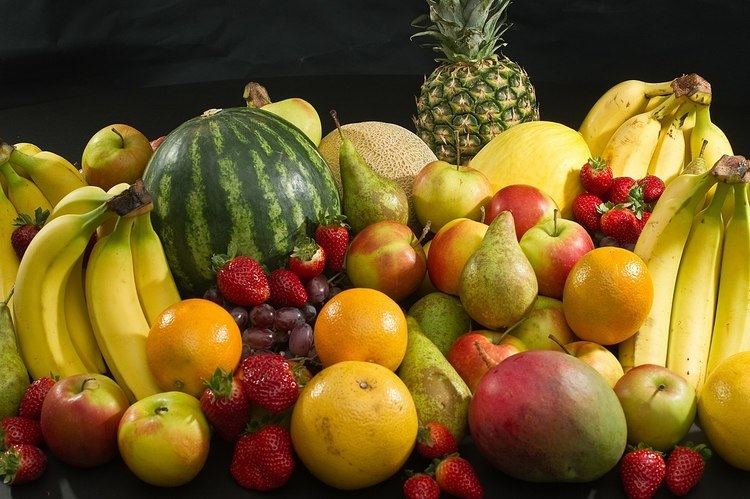 | ||
This list of culinary fruits contains the names of some fruits that are considered edible in some cuisines. The word "fruit" is used in several different ways. The definition of fruit for these lists is a culinary fruit, i.e. "Any sweet, edible part of a plant that resembles fruit, even if it does not develop from a floral ovary; also used in a technically imprecise sense for some sweet or sweetish vegetables, some of which may resemble a true fruit or are used in cookery as if they were a fruit, for example rhubarb." Note that many edible plant parts that are true fruits botanically speaking, are not considered culinary fruits. They are classified as vegetables in the culinary sense (for example: the tomato, zucchini, and so on), and hence they do not appear in this list. Similarly, some botanical fruits are classified as nuts (e.g. Brazil nut and various almonds), or staples (e.g. breadfruit), and likewise do not appear here. There also exist many fruits which are edible and palatable but for various reasons have not become popular.
Contents
- T
- Temperate fruits
- Berries
- Mediterranean and subtropical fruits
- Citrus
- Tropical fruits
- Z
- Fruits of African origin
- Fruits of Asian origin
- Fruits of Latin American origin
- Fruits of North American origin
- Fruits of Oceanian origin
- Rosaceae family
- Cacti and other succulents
- Gymnosperms with fruit like structures
- Podocarps
- Other gymnosperms
- Melons and other members of Cucurbitaceae family
- Accessory fruits
- References
T
Temperate fruits
Fruits of temperate climates are almost always borne on trees or woody shrubs or lianas. They will not grow adequately in the tropics, as they need a period of cold (a chilling requirement) each year before they will flower. The apple, pear, cherry, and plum are the most widely grown and eaten, owing to their adaptability. Many other fruits are important regionally but do not figure prominently in commerce. Many sorts of small fruit on this list are gathered from the wild, just as they were in Neolithic times.
Berries
In non-technical usage, berry means any small fruit that can be eaten whole and lacks objectionable seeds. The bramble fruits, compound fruits of genus Rubus (blackberries), are some of the most popular of these that are not true berries:
Rubus
True berries
The true berries are dominated by the family Ericaceae, many of which are hardy in the subarctic:
Other berries
Mediterranean and subtropical fruits
Fruits in this category are not hardy to extreme cold, as the preceding temperate fruits are, yet tolerate some frost and may have a modest chilling requirement. Notable among these are natives of the Mediterranean:
Citrus
In the important genus Citrus (Rutaceae), some members are tropical, tolerating no frost. All common species of commerce are somewhat hardy:
See also: List of Citrus fruitsTropical fruits
Tropical fruits grow on plants of all habitats. The only characteristic that they share is an intolerance of frost.
Z
Zucchini
Fruits of African origin
Fruits native to Africa or of African origin:
Fruits of Asian origin
Fruits native to Asia or of Asian origin:
Fruits of Latin American origin
Fruits native to Latin America or of Latin American origin. Plants are of South American origin, except as noted.
Fruits of North American origin
Canada and the United States are home to a surprising number of edible plants, especially berries; however, only three are commercially grown/known on a global scale (grapes, cranberries, and blueberries.) Many of the fruits below are still eaten locally as they have been for centuries and others are generating renewed interest by eco-friendly gardeners (less need for bug control) and chefs of the region alike.
Fruits of Oceanian origin
Fruits native to Oceania or of Oceanian origin:
Rosaceae family
The family Rosaceae dominates the temperate fruits, both in numbers and in importance. The pome fruits, stone fruits and brambles are fruits of plants in Rosaceae.
The pome fruits:
The stone fruits, drupes of genus Prunus:
Berries
In non-technical usage, berry means any small fruit that can be eaten whole and lacks objectionable seeds. The bramble fruits, compound fruits of genus Rubus (blackberries), are some of the most popular of these that are not true berries:
The true berries are dominated by the family Ericaceae, many of which are hardy in the subarctic:
Other berries not in Rosaceae or Ericaceae:
Cacti and other succulents
Several cacti yield edible fruits, which are important traditional foods for some Native American peoples:
Gymnosperms with fruit-like structures
Only Angiosperms have fruit, a structure that surrounds the seed. Gymnosperms have naked seeds, but some of them have reproductive structures that resemble fruit.
Podocarps
Podocarps are conifers in the family Podocarpaceae, The seed cones are highly modified and, in some, the seed is surrounded by fleshy scale tissue, resembling a drupe. These berry-like cone scales are eaten by birds which then disperse the seeds in their droppings and the cones can be eaten in many species. Podocarps are either half-hardy or frost tender, depending on species. Many genera are similar in that they have edible "fruits" and often don't have a common name.
Other gymnosperms
Melons and other members of Cucurbitaceae family
Most gourds and many melons are regarded as culinary vegetables. The following are generally regarded as fruits:
Accessory fruits
The accessory fruits, seed organs which are not botanically berries at all:
